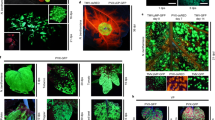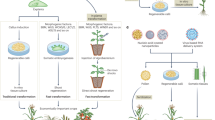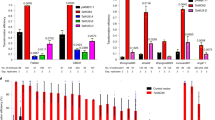Abstract
Selectable marker genes are required to ensure the efficient genetic modification of crops. Economic incentives and safety concerns have prompted the development of several strategies (site-specific recombination, homologous recombination, transposition, and co-transformation) to eliminate these genes from the genome after they have fulfilled their purpose. Recently, chemically inducible site-specific recombinase systems have emerged as valuable tools for efficiently regulating the excision of transgenes when their expression is no longer required. The implementation of these strategies in crops and their further improvement will help to expedite widespread public acceptance of agricultural biotechnology
This is a preview of subscription content, access via your institution
Access options
Subscribe to this journal
Receive 12 print issues and online access
$209.00 per year
only $17.42 per issue
Buy this article
- Purchase on Springer Link
- Instant access to full article PDF
Prices may be subject to local taxes which are calculated during checkout


Similar content being viewed by others
References
Ebinuma, H., Sugita, K., Matsunaga, E. & Yamakado, M. Selection of marker-free transgenic plants using the isopentenyltransferase gene. Proc. Natl. Acad. Sci. USA 94, 2117–2121 (1997).
Kunkel, T., Niu, Q.-W., Chan, Y.-S. & Chua, N.-H. Inducible isopentenyltransferase as a high-efficiency marker for plant transformation. Nat. Biotechnol. 17, 916–919 (1999).
Zuo, J., Niu, Q.-W., Ikeda, Y. & Chua, N.-H. Marker-free transformation: increasing transformation frequency by the use of regeneration-promoting genes. Curr. Opin. Biotechnol., in press (2002).
Hohn, B., Levy, A.A. & Puchta, H. Elimination of selection markers from transgenic plants. Curr. Opin. Biotechnol. 12, 139–143 (2001).
Ow, D. Marker genes. in Joint FAO/WHO Expert Consultation on Foods Derived from Biotechnology, World Health Organization, May 29–June 2, 2000 (World Health Organization, Geneva, Switzerland, 2000). http://www.who.int/fsf/GMfood/Consultation_May2000/Biotech_00_14.pdf.
Ebinuma, H. et al. Systems for the removal of a selection marker and their combination with a positive marker. Plant Cell Rep. 20, 383–392 (2001).
Daniell, H., Khan, M.S. & Allison, L. Milestones in chloroplast genetic engineering: an environmentally friendly era in biotechnology. Trends Plant Sci. 7, 84–91 (2002).
Maliga, P. Engineering the plastid genome of higher plants. Curr. Opin. Plant Biol. 5, 164–172 (2002).
Ow, D.W. Recombinase-directed plant transformation for the post genomic era. Plant Mol. Biol. 48, 183–200 (2002).
Hoff, T., Schnorr, K.M. & Mundy, J. A recombinase-mediated transcriptional induction system in transgenic plants. Plant Mol. Biol. 45, 41–49 (2001).
Luo, H., Lyznik, L.A., Gidoni, D. & Hodges, T.K. FLP-mediated recombination for use in hybrid plant production. Plant J. 23, 423–430 (2000).
Keenan, R.J. & Stemmer, W.P.C. Nontransgenic crops from transgenic plants. Nat. Biotechnol. 20, 215–216 (2002).
Lu, H.-J., Zhou, X.R., Gong, Z.-X. & Upadhyaya, N.M. Generation of selectable marker-free transgenic rice using double right-border (DRB) binary vectors. Aust. J. Plant Physiol. 28, 241–248 (2001).
Zubko, E., Scutt, C. & Meyer, P. Intrachromosomal recombination between attP regions as a tool to remove selectable marker genes from tobacco transgenes. Nat. Biotechnol. 18, 442–445 (2000).
Zuo, J., Niu, Q.-W., Møller, S.G. & Chua, N.-H. Chemical-regulated, site-specific DNA excision in transgenic plants. Nat. Biotechnol. 19, 157–161 (2001).
Gleave, A.P., Mitra, D.S., Mudge, S.R. & Morris, B.A.M. Selectable marker-free transgenic plants without sexual crossing: transient expression of cre recombinase and use of a conditional lethal dominant gene. Plant Mol. Biol. 40, 223–235 (1999).
Dale, E.C. & Ow, D.W. Gene transfer with the subsequent removal of the selection gene from the host genome. Proc. Natl. Acad. Sci. USA 88, 10558–10562 (1991).
Russell, S.H., Hoopes, J.L. & Odell, J.T. Directed excision of a transgene from the plant genome. Mol. Gen. Genet. 234, 49–59 (1992).
Lyznik, L.A., Rao, K.V. & Hodges, T.K. FLP-mediated recombination of FRT sites in the maize genome. Nucleic Acids Res. 24, 3784–3789 (1996).
Sugita, K., Kasahara, T., Matsunaga, E. & Ebinuma, H. A transformation vector for the production of marker-free transgenic plants containing a single copy transgene at high frequency. Plant J. 22, 461–469 (2000).
Ebinuma, H. & Komamine, A. MAT (Multi-Auto-Transformation) Vector System. The oncogenes of Agrobacterium as positive markers for regeneration and selection of marker-free transgenic plants. In Vitro Cell. Dev. Biol. Plant 37, 103–113 (2001).
Srivastava, V., Anderson, O.A. & Ow, D.W. Single-copy transgenic wheat generated through the resolution of complex integration patterns. Proc. Natl. Acad. Sci. USA 96, 11117–11121 (1999).
Corneille, S., Lutz, K., Svab, Z. & Maliga, P. Efficient elimination of selectable marker genes from the plastid genome by the CRE–lox site-specific recombination system. Plant J. 27, 171–178 (2001).
Hajdukiewicz, P.T.J., Gilbertson, L. & Staub, J.M. Multiple pathways for Cre/lox-mediated recombination in plastids. Plant J. 27, 161–170 (2001).
Thyagarajan, G., Guimaraes, M.J., Groth, A.C. & Calos, M.P. Mammalian genomes contain active recombinase recognition sites. Gene 244, 47–54 (2000).
Schmidt, E.E., Taylor, D.S., Prigge, J.R., Barnett, S. & Capecchi, M. Illegitimate Cre-dependent chromosome rearrangements in transgenic mouse spermatids. Proc. Natl. Acad. Sci. USA 97, 13702–13707 (2000).
Loonstra, A. et al. Growth inhibition and DNA damage induced by Cre recombinase in mammalian cells. Proc. Natl. Acad. Sci. USA 98, 9209–9214 (2001).
Zuo, J. & Chua, N.-H. Chemical-inducible systems for regulated expression of plant genes. Curr. Opin. Biotechnol. 11, 146–151 (2000).
Iamthan, S. & Day, A. removal of antibiotic resistance genes from transgenic tobacco plastids. Nat. Biotechnol. 18, 1172–1176 (2000).
Srivastava, V. & Ow, D.W. Single-copy primary transformamts of maize obtained through the co-introduction of a recombinase-expressing construct. Plant Mol. Biol. 46, 561–566 (2001).
Ziemienowicz, A., Tinland, B., Bryant, J., Gloeckler, V. & Hohn, B. Plant enzymes but not Agrobacterium VirD2 mediate T-DNA ligation in vitro. Mol. Cell. Biol. 20, 6317–6322 (2000).
Vergunst, A.C. et al. VirB/D4-dependent protein translocation from Agrobacterium into plant cells. Science 290, 979–982 (2000).
Davies, G.J., Kilby, N.J., Riou-Khamlichi, C. & Murray, J.A.H. Somatic and germinal inheritance of an FLP-mediated deletion in transgenic tobacco. J. Exp. Bot. 50, 1447–1456 (1999).
Gidoni, D. et al. Embryonal recombination and germline inheritance of recombined FRT loci mediated by constitutively expressed FLP in tobacco. Euphytica 121, 145–156 (2001).
Buchholz, F. & Stewart, A.F. Alteration of Cre recombinase site specificity by substrate-linked protein evolution. Nat. Biotechnol. 19, 1047–1052 (2001).
Sclimenti, C.R., Thayagarajan, B. & Calos, M.P. Directed evolution of a recombinase for improved genomic integration at a native human sequence. Nucl. Acids Res. 29, 5044–5051.
Santoro, S.W. & Schultz, P.G. Directed evolution of the site specificity of Cre recombinase. Proc. Natl. Acad. Sci. USA 99, 4185–4190 (2002).
Baszczynski, C.L. et al. Novel nucleic acid sequence encoding FLP recombinase. US patent 6,175,058 (2001).
Lorbach, E., Christ, N., Schwikardi, M. & Dröge, P. Site-specific recombination in human cells catalyzed by phage λ integrase mutants. J. Mol. Biol. 296, 1175–1181 (2000).
Urwin, P., Li, Y., Martin, H., Atkinson, H. & Gilmartin, P.M. Functional characterization of the EMCV IRES in plants. Plant J. 24, 583–589 (2000).
Kumar, S. & Fladung, M. Controlling transgene integration in plants. Trends Plant Sci. 6, 155–159 (2001).
Bibikova, M. et al. Stimulation of homologous recombination through targeted cleavage by chimeric nucleases. Mol. Cell. Biol. 21, 289–297 (2001).
van Duyne, G.D. A structural view of Cre-loxP site-specific recombination. Annu. Rev. Biophys. Biomol. Struct. 30, 87–104 (2001).
Guo, H. et al. Group II introns designed to insert into therapeutically relevant DNA target sites in human cells. Science 289, 452–457 (2000).
Kuiper, H.A., Kleter, G.A., Noteborn, H.P.J.M. & Kok, E.J. Assessment of the food safety issues related to genetically modified foods. Plant J. 27, 503–528 (2001).
Goddijn, O.J.M., Schouten, P.M.V., Schilperoort, R.A. & Hoge, J.H.C. A chimeric tryptophan decarboxylase gene as a novel selectable marker in plant cells. Plant Mol. Biol. 22, 907–912 (1993).
Joersbo, M. & Okkels, F.T. A novel principle for selection of transgenic plant cells: positive selection. Plant Cell Rep. 16, 219–221 (1996).
Haldrup, A., Petersen, S.G. & Okkels, F.T. The xylose isomerase gene from Thermoanaerobacterium thermosulfurogenes allows effective selection of transgenic plant cells using D-xylose as the selection agent. Plant Mol. Biol. 37, 287–296 (1998).
Joersbo, M. et al. Analysis of mannose selection used for transformation of sugar beet. Mol. Breed. 4, 111–117 (1998).
Qin, M., Bayley, C., Stockton, T. & Ow, D.W. Cre recombinase-mediated site-specific recombination between plant chromosomes. Proc. Natl. Acad. Sci. USA 91, 1706–1710 (1994).
O'Keefe, D.P. et al. Plant expression of a bacterial cytochrome P450 that catalyzes activation of a sulfonylurea pro-herbicide. Plant Physiol. 105, 473–482 (1994)
Næstaed, H. et al. A bacterial haloalkane dehalogenase gene as a negative selectable marker in Arabidopsis. Plant J. 18, 571–576 (1999).
Acknowledgements
We thank Paula Duque and Diana Horvath for critical evaluation of the manuscript.
Author information
Authors and Affiliations
Corresponding author
Rights and permissions
About this article
Cite this article
Hare, P., Chua, NH. Excision of selectable marker genes from transgenic plants. Nat Biotechnol 20, 575–580 (2002). https://doi.org/10.1038/nbt0602-575
Received:
Accepted:
Issue Date:
DOI: https://doi.org/10.1038/nbt0602-575
This article is cited by
-
Cre-mediated autoexcision of selectable marker genes in soybean, cotton, canola and maize transgenic plants
Plant Cell Reports (2023)
-
The potential applications of site-directed mutagenesis for crop improvement: a review
Journal of Crop Science and Biotechnology (2021)
-
Opportunities and challenges applying gene editing to specialty crops
In Vitro Cellular & Developmental Biology - Plant (2021)
-
Development of marker-free insect resistant transgenic okra (Abelmoschus esculentus L. Moench) expressing the cry1Ac gene and identification of vector backbone-free events
Physiology and Molecular Biology of Plants (2021)
-
Comparison of three Agrobacterium-mediated co-transformation methods for generating marker-free transgenic Brassica napus plants
Plant Methods (2020)



